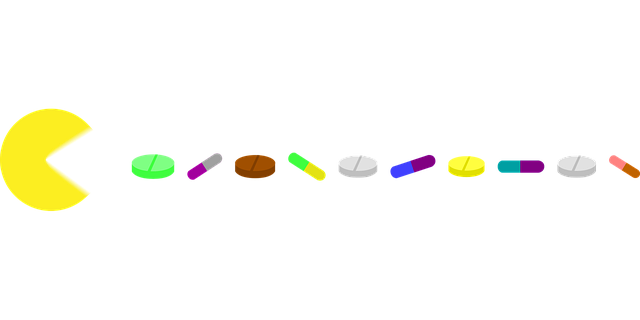TL;DR:
Semaglutide medication revolutionizes Type 2 diabetes management by mimicking natural GLP-1 hormones to regulate blood sugar levels. Through injections or oral tablets, it achieves sustained glycemic control, reduces HbA1c levels, promotes weight loss, and lowers diabetes-related risks. Clinical trials highlight its effectiveness in preventing long-term complications and improving quality of life, with once-weekly administration simplifying patient adherence compared to daily insulin injections. However, potential side effects like gastrointestinal issues necessitate dosage adjustments and monitoring for kidney function and blood pressure. Future research aims to expand its use and enhance accessibility through personalized medicine approaches.
“Discover how semaglutide medication is transforming diabetes management with its ability to offer sustained glycemic control. This comprehensive guide explores the innovative treatment options provided by this novel approach, focusing on Type 2 Diabetes. From understanding glycemic control and its significance in diabetes management, to the mechanism of action of semaglutide and clinical trial evidence supporting its efficacy, we delve into the benefits, potential side effects, administration details, and real-world applications of this game-changing therapy.”
Understanding Glycemic Control and Its Importance in Diabetes Management

Glycemic control refers to the ability to maintain stable blood sugar levels, which is a critical aspect of managing diabetes. For individuals with diabetes, especially type 2 diabetes, achieving and sustaining optimal glycemic control can significantly reduce the risk of long-term complications. These complications include nerve damage, kidney disease, eye problems, and cardiovascular issues. The importance of tight glycemic management cannot be overstated, as it not only improves overall health but also enhances quality of life.
One effective approach to achieving sustained glycemic control is through the use of semaglutide medication. Semaglutide is a glucagon-like peptide-1 (GLP-1) receptor agonist that mimics the effects of a natural hormone produced by the body. By mimicking this hormone, semaglutide aids in regulating blood sugar levels, promoting weight loss, and reducing the risk of diabetes-related complications. Its ability to provide long-lasting control makes it a valuable tool in diabetes management, offering potential benefits such as improved insulin sensitivity, reduced hepatic glucose production, and delayed gastric emptying.
Introduction to Semaglutide: A Novel Approach for Type 2 Diabetes Treatment

Semaglutide is a groundbreaking medication that has emerged as a novel approach to managing Type 2 diabetes. It belongs to a class of drugs known as glucagon-like peptide-1 (GLP-1) receptor agonists, which mimic the effects of a natural hormone in the body. This hormone, GLP-1, plays a crucial role in regulating blood sugar levels by stimulating insulin release and suppressing glucagon secretion.
By administering semaglutide, either through injection or an oral tablet (depending on the formulation), healthcare providers can offer sustained glycemic control. This medication has shown promising results in clinical trials, demonstrating its ability to significantly reduce HbA1c levels—a key marker of long-term blood sugar control. Its unique mode of action not only aids in weight management but also provides a more natural and sustainable approach to diabetes treatment compared to traditional insulin therapy or other existing GLP-1 receptor agonists.
Mechanism of Action: How Semaglutide Regulates Blood Sugar Levels

Semaglutide, a medication widely recognized for its role in glycemic control, exerts its effect primarily through its interaction with specific receptors in the body. This injectable drug mimics the action of a natural hormone called GLP-1 (glucagon-like peptide-1), which is secreted in response to food intake. By activating GLP-1 receptors, semaglutide triggers several physiological processes that collectively lead to improved blood sugar levels.
One key mechanism involves slowing down the rate at which the stomach empties its contents into the small intestine, thereby delaying the absorption of glucose from food. Additionally, semaglutide stimulates insulin secretion from the pancreas in a glucose-dependent manner, promoting the uptake of glucose by cells and reducing its circulation. Furthermore, it suppresses glucagon release, a hormone that increases blood sugar levels, contributing to sustained glycemic control over time.
Clinical Trials and Evidence Supporting Semaglutide's Efficacy

Clinical trials have played a pivotal role in establishing the efficacy and safety of semaglutide as a medication for glycemic control. These studies, conducted under stringent conditions, have consistently demonstrated semaglutide’s ability to significantly lower blood sugar levels in individuals with type 2 diabetes. The evidence is compelling: participants in clinical trials experienced reduced HbA1c levels, a marker of long-term blood sugar control, and many also achieved normoglycemia (normal blood sugar levels).
The trials have further highlighted semaglutide’s potential to reduce body weight, an added benefit for patients often struggling with obesity alongside diabetes. This dual action makes semaglutide a game-changer in diabetes management, offering sustained glycemic control and contributing to improved overall health outcomes for those living with the condition.
Benefits of Semaglutide Medication for Sustained Glycemic Control

Semaglutide medication offers significant advantages for maintaining stable blood sugar levels, making it a valuable tool in diabetes management. This innovative therapy mimics the action of natural hormones, enhancing insulin secretion and suppressing glucagon production when blood glucose levels rise. As a result, it facilitates better control of glycemic (blood sugar) peaks after meals, which is particularly beneficial for individuals with type 2 diabetes or those struggling to manage their condition effectively.
One of the key benefits of semaglutide medication lies in its once-weekly administration, simplifying patient adherence to treatment routines compared to daily insulin injections. Additionally, clinical trials have demonstrated significant reductions in HbA1c (a long-term marker of blood sugar control) levels, indicating its effectiveness in preventing both short-term spikes and long-lasting glycemic damage associated with diabetes.
Potential Side Effects and Safety Considerations

The semaglutide medication, while offering sustained glycemic control for individuals with type 2 diabetes, is not without potential side effects. Common adverse reactions include nausea, vomiting, diarrhea, and constipation—gastrointestinal issues that may impact daily life. These side effects are often temporary but can be bothersome, requiring adjustments in dosage or eating habits.
Safety considerations are paramount when using semaglutide. As with any medication, there is a risk of allergic reactions, and patients should inform their healthcare providers about any known allergies or existing medical conditions. Additionally, regular monitoring of kidney function and blood pressure is essential to ensure the medication remains safe and effective over time.
Administering Semaglutide: Dosage, Delivery Methods, and Patient Education

Semaglutide is administered via several delivery methods, each offering specific advantages for patients. The most common method is subcutaneous injection, typically given once weekly. The dosage starts at a low level and gradually increases to maintain optimal glycemic control while minimizing side effects. This medication is often prescribed for type 2 diabetes patients who require enhanced glycemic management.
Patient education plays a vital role in the successful administration of semaglutide. They must be taught how to correctly inject the medication, store it properly, and recognize potential adverse reactions. Regular monitoring of blood sugar levels is essential, as is keeping a log to share with healthcare providers during follow-up appointments. By adhering to these guidelines, patients can effectively manage their diabetes and enjoy improved overall health.
Real-World Applications and Future Perspectives

In real-world applications, the semaglutide medication has shown remarkable effectiveness in managing type 2 diabetes. Its ability to offer sustained glycemic control makes it a valuable addition to the arsenal of treatments available to healthcare professionals. Patients have reported improved quality of life and reduced complications associated with poorly managed diabetes. The medication’s long-acting nature ensures consistent blood sugar levels, providing a stable foundation for patients’ overall health.
Looking ahead, future perspectives for semaglutide are promising. Ongoing research explores its potential in various patient populations, including those with obesity and cardiovascular risks. Additionally, the development of new formulations and delivery methods could enhance accessibility and patient compliance. As technology advances, there is a growing emphasis on personalized medicine, where treatments like semaglutide can be tailored to individual needs, marking an exciting direction for diabetes management in the years to come.
